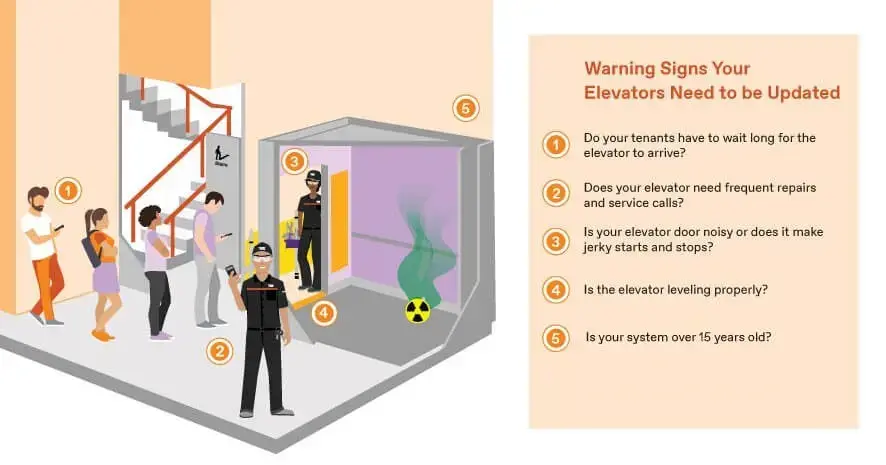Noise, jerky stops and starts, and frequent callbacks - these are warning signs your elevators are leaving your tenants at a standstill. Although reliable elevator maintenance services and professional elevator repair can keep your elevators safely moving for 12 to 15 years, eventually your elevator, like all machines, will reach the end of its service life.
Before you face the nightmare scenario of potentially extended elevator downtime, you’ll need to start thinking about elevator modernization, which replaces critical elevator components with advanced code-compliant equipment. A modernization can make your elevator perform and look like new.
Because modernizations can be a considerable investment, we’ve created a list to help you determine when the time could be near.

1. Do your tenants have to wait long for the elevator to arrive?
Most modernizations improve elevator traffic efficiency based on traffic analysis studies. You can also add a destination dispatch solution that optimizes elevator travel times and reduces building traffic.
2. Does your elevator need frequent repairs and service calls?
Like aging automobiles, your aging equipment can go out of service more frequently, and it can become harder to obtain replacement parts. Frequent elevator breakdowns can also cause tenant frustration to grow. Modernization can prevent these scenarios.
3. Is your elevator door noisy or does it make jerky starts and stops?
This can be a sign of aging door operator technology, which is the leading cause of elevator breakdowns. Most modernization packages include door operator replacement and hoistway door refurbishment.
4. Is the elevator leveling properly?
In older elevators, improper leveling can cause passenger missteps or even falls due to motor issues or aging leveling technology. Modernizations replace these outdated parts with newer components, which helps passengers safely enter and exit your elevators.
5. Is your system over 15 years old?
Elevator components rely on electronics as well as mechanical parts to function. These components include parts supplied by external vendors. Sometimes, vendors discontinue the production of these parts.
If the discontinued part stops functioning on your elevator, the entire system can go out of service, and it can be extremely challenging and costly to return your elevator to operation. This is not a situation you want to explain to your tenants, and it can happen in spite of your elevator receiving regular high-quality service and maintenance.
The good news is your regularly scheduled service, and maintenance can potentially let you know of a part that might need to be replaced, so you can budget for larger repairs more effectively and avoid downtime. However, a full modernization is typically the best long-term solution for aging equipment.

If you’re answering yes to most of these questions, get your elevator surveyed to determine its performance, safety, and code compliance. This process measures acceleration, deceleration, vibration, door opening times, sound and reveals components most in need of improvement.
Once you have the results, work with an elevator professional to determine if a modernization is necessary or if other solutions can be tailored to your budget. You can also develop a plan to phase in larger improvements to help keep your budget in line.
And you must also consider your tenants. Unlike new elevator installations, modernizations take place in a live building environment. This means installation teams will be working each day in a building full of tenants. There will be periods of inconvenience and noise, so work with professionals that have the ability to quickly understand, address, and prevent problems.
Each building and modernization project is unique, so reach out to us because knowledgeable and resourceful experts are a must.
 Saudi Arabia
Saudi Arabia

